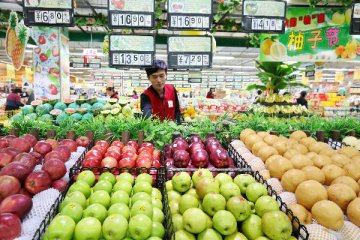
China's inflation accelerated faster than expected in August, but remained mild overall, leaving policy makers room for containing financial leverage and risks. < Fresh data showed Saturday that consumer price index (CPI), a main gauge of inflation, rose to a seven-month high of 1.8 percent in August, compared with July's 1.4 percent, beating market expectations of 1.6 percent.
For the first eight months of the year, CPI climbed 1.5 percent from one year earlier, according to data from the National Bureau of Statistics (NBS).
The core consumer inflation, which excludes volatile food and energy prices, increased 2.2 percent year on year in August, up slightly from July's 2.1 percent. The core CPI has been holding steady at a little above 2 percent since March.
The stronger, yet still moderate, consumer inflation remained below the government's annual target of around 3 percent set for 2017.
Producer price index (PPI), which measures costs of goods at the factory gate, climbed to a four-month high of 6.3 percent in August, compared with 5.5 percent in July, according to NBS.
PPI growth, which was higher than the market forecast of 5.7 percent, was boosted by increases in the prices of steel, non-ferrous metals, as well as oil and natural gas.
Analysts said the pick-up in inflation is unlikely to continue because of a high comparative base in September 2016 and the fading effects of seasonal factors during the rest of the year.
Jiang Chao, chief economist at Haitong Securities, said the CPI increase would ease to 1.6 percent in September and remain subdued for the whole year.
Prices of coal, steel and other metals continued to rise in September amid the government's efforts to reduce industrial overcapacity and enhance environmental regulations, but Jiang expected September's PPI growth to fall to 5.8 percent due to a calculation factor in higher prices for the same month last year.
Guosen Securities analyst Dong Dezhi said the growth of CPI and PPI in August would be their peak this year.
August's price data added to a slew of upside surprises in the world's second-largest economy, which has defied market expectations of a slowdown.
Producer prices accelerated upward, a significant positive sign for China's economy, which will help drive profits higher and enable companies to process their debt burden a little more easily, Bloomberg chief Asia economist Tom Orlik said.
Surging housing prices in major cities and investment booms in financial markets -- ranging from stocks and bonds to farm produce futures -- made policy makers wary of debt piling up in enterprises, local governments and households, and prioritizing financial risk control in 2017.
Since the end of 2016, authorities have tightened financial regulation and credit control, and have been using an expanded monetary toolkit to manage liquidity.
With downward pressure and increasing global market uncertainty complicating the outlook, analysts said the mild inflation and steady growth momentum would give policy makers more scope to continue deleveraging.
Orlik expected the central bank to continue dealing with the deleveraging challenge, not to hasten monetary easing.
CICC analyst Liu Wenqi said monetary policy would stay largely neutral, but also be ready to be "fine-tuned" on potential changes in growth and inflation trajectory.
The government's ongoing drive to contain financial risks will see credit growth slowing further in the coming months, including credit flows to local governments, which may soften fixed-asset investment and weigh on economic activity, UBS economist Wang Tao said.
However, Wang expected growth to stay firm before softening modestly going into the year end.
GDP grew 6.9 percent in the first half of the year, well above the government's target of around 6.5 percent for the year.























Latest comments